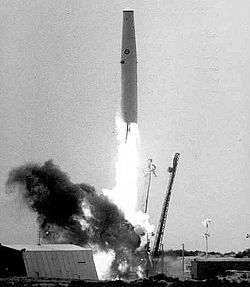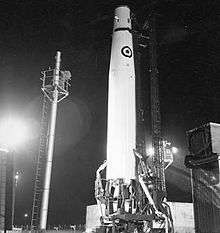Project Emily

Project Emily was the deployment of American-built PGM-17 Thor intermediate-range ballistic missiles in the United Kingdom between 1959 and 1963.
Royal Air Force (RAF) Bomber Command operated 60 Douglas Thor Intermediate Range Ballistic Missiles, dispersed to 20 RAF air stations, as part of the UK nuclear deterrent force.
Due to concerns over the buildup of Soviet missiles, US President Dwight D. Eisenhower met Prime Minister Harold Macmillan in Bermuda in March 1957 to explore the possibility of short-term deployment on UK soil, until more powerful intercontinental ballistic missiles were deployed.
During the Cuban Missile Crisis, 59 of the RAF missiles, with their W49 1.44 megaton thermonuclear warheads, were brought to operational readiness.
Intended to remain in place until 1968, the missile force was disbanded in 1963, and the missiles were returned to the U.S., most for eventual use in developing hardware and techniques as part of the space race.
RAF Strategic Missile (SM) stations and squadrons
Originally conceived as a four-squadron deployment, with each squadron controlling five "flights" of three missiles each, these flights were subsequently reconfigured into separate squadrons. For example, on 22 July 1959, C Flight of No. 77 Squadron was redesignated No. 107 Squadron.[1]
The subsequent deployment was based on 4 "Strategic Missile Groups", each comprising five squadrons, and each squadron being equipped with three missiles.
The groups were based at RAF stations at Driffield, Feltwell, Hemswell and North Luffenham,[2] with their satellite bases in close proximity:
North Luffenham and Feltwell came under No. 3 Group RAF, Air Vice-Marshal Michael Harington Dwyer Air Officer Commanding. Feltwell was also home to Bomber Command Strategic Missile School.[3]
| Station | County | Squadron | Reformed[5] | Operational | Disbanded[5] |
|---|---|---|---|---|---|
| Feltwell Group | |||||
| RAF Feltwell[3] | Norfolk | 77(SM) | 1 September 1958 | 9 January 1959 | 10 July 1963 |
| RAF Shepherds Grove | Suffolk | 82(SM) | 22 July 1959 | 22 July 1959 | 10 July 1963 |
| RAF Tuddenham | Suffolk | 107(SM) | 22 July 1959 | 22 July 1959 | 10 July 1963 |
| RAF Mepal | Cambridgeshire | 113(SM) | 22 July 1959 | 22 July 1959 | 10 July 1963 |
| RAF North Pickenham | Norfolk | 220(SM) | 22 July 1959 | 22 July 1959 | 10 July 1963 |
| Hemswell Group | |||||
| RAF Hemswell | Lincolnshire | 97(SM) | 1 December 1958 | 12 January 1959 | 24 May 1963 |
| RAF Ludford Magna | Lincolnshire | 104(SM) | 22 July 1959 | 22 July 1959 | 24 May 1963 |
| RAF Bardney | Lincolnshire | 106(SM) | 22 July 1959 | 22 July 1959 | 24 May 1963 |
| RAF Coleby Grange | Lincolnshire | 142(SM) | 22 July 1959 | 22 July 1959 | 24 May 1963 |
| RAF Caistor | Lincolnshire | 269(SM) | 22 July 1959 | 22 July 1959 | 24 May 1963 |
| Driffield Group | |||||
| RAF Driffield | Yorkshire | 98(SM) | 1 August 1959 | 8 January 1959 | 18 April 1963 |
| RAF Full Sutton | Yorkshire | 102(SM) | 1 August 1959 | 8 January 1959 | 27 April 1963 |
| RAF Carnaby | Yorkshire | 150(SM) | 1 August 1959 | 8 January 1959 | 9 April 1963 |
| RAF Catfoss | Yorkshire | 226(SM) | 1 August 1959 | 8 January 1959 | 9 March 1963 |
| RAF Breighton | Yorkshire | 240(SM) | 1 August 1959 | 8 January 1959 | 8 January 1963 |
| North Luffenham Group | |||||
| RAF North Luffenham | Rutland | 144(SM) | 1 December 1959 | 12 January 1959 | 23 August 1963 |
| RAF Polebrook | Northamptonshire | 130(SM) | 1 December 1959 | 12 January 1959 | 23 August 1963 |
| RAF Folkingham | Lincolnshire | 223(SM) | 1 December 1959 | 12 January 1959 | 23 August 1963 |
| RAF Harrington | Northamptonshire | 218(SM) | 1 December 1959 | 12 January 1959 | 23 August 1963 |
| RAF Melton Mowbray | Leicestershire | 254(SM) | 1 December 1959 | 12 January 1959 | 23 August 1963 |
To defend the stations from enemy aircraft, RAF squadrons were raised with the Bristol Bloodhound surface-to-air missile: No. 112 Squadron was based at RAF Breighton, and No. 247 Squadron at RAF Carnaby from 1960.[6][7]
Missile launches by RAF personnel

Over twenty RAF crews visited the USA for training, culminating in operational training launches from Vandenberg AFB:[8]
The RAF personnel were trained by the 392nd Missile Training Squadron of the 704th Strategic Missile Wing of the 1st Missile Division, (USAF).
| Launch date | Launch pad | Code name | Notes |
|---|---|---|---|
| 1959 | |||
| 16 April"U.S. Missile Tour...". Flight. 78 (2622): 580. 24 April 1959. Retrieved 9 October 2015. | 75-2-8 | Lions Roar | attended by Air Vice-Marshals W C Sheen[9] and Sir Augustus Walker |
| 16 June | 75-2-7 | Rifle Shot | |
| 3 August | 75-1-1 | Bean Ball | |
| 14 August | 75-2-6 | Short Skip | |
| 17 September | 75-1-2 | Grease Gun | |
| 6 October | 75-2-8 | Foreign Travel | attended by Lord and Lady Mountbatten |
| 21 October | 75-1-1 | Stand Fast | |
| 12 November | 75-1-2 | Beach Buggy | |
| 1 December | 75-1-1 | Hard Right | |
| 14 December | 75-1-2 | Tall Girl | |
| 1960 | |||
| 21 January | 75-1-2 | Red Caboose | |
| 2 March | 75-2-8 | Center Board | |
| 22 June | 75-2-7 | Clan Chattan | First missile returned from the UK for launch |
| 11 October | 75-2-8 | Left Rudder | |
| 13 December | 75-2-8 | Acton Town | |
| 1961 | |||
| 29 March | 75-2-7 | Shepherds Bush | |
| 20 June | 75-2-7 | White Bishop | |
| 6 September | LE-7 | Skye Boat | |
| 5 December | LE-8 | Pipers Delight | |
| 1962 | |||
| 19 March | LE-7 | Black Knife | |
| 18 June | LE-8 | Blazing Ciders | |
Listed status
In October 2012 the former launch sites at Harrington and North Luffenham were granted listed status.[10]
References
- Notes
- ↑ "107 Squadron". Royal Air Force. 2015. Retrieved 9 October 2015.
- 1 2 "RAF Thor Missile Units". orbat.com. Retrieved 6 September 2010.
- 1 2 Barrass, M. B. (2015). "RAF Stations (F): Feltwell". Air of Authority - A History of RAF Organisation. Retrieved 9 October 2015.
- ↑ various official squadron histories
- 1 2 Jefford 1988, pp. 48-81
- ↑ Barrass, M. B. (2015). "No. 111–115 Squadron Histories". Air of Authority - A History of RAF Organisation. Retrieved 9 October 2015.
- ↑ Barrass, M. B. (2015). "No. 246–250 Squadron Histories". Air of Authority - A History of RAF Organisation. Retrieved 9 October 2015.
- ↑ "Vandenberg AFB Launch history". Space Archive. Brian Webb. 3 May 2010. Retrieved 6 September 2010.
- ↑ Barrass, M. B. (2015). "Air Vice-Marshal Walter Charles Sheen". Air of Authority - A History of RAF Organisation. Retrieved 9 October 2015.
- ↑ "Cold War missile sites get listed status". BBC News. 16 October 2012. Retrieved 9 October 2015.
- Bibliography
- Official website
- "Thor Missile deployment in the UK". Carpetbagger Aviation Museum.
The following text has been taken from STRIKE FORCE - The USAF in Britain since 1948 by Robert Jackson
- Jefford, C. G. (1988). RAF Squadrons. Airlife Publishing Ltd. ISBN 1-85310-053-6.
Further reading
- John Boyes Project Emily: Thor IRBM and the RAF ISBN 0-7524-4611-8
- Kenneth Cross Bomber Command's Thor Missile Force The RUSI Journal, Volume 108, Issue 630 May 1963, pages 131 - 136
- Jim Wilson Launch Pad UK: Britain and the Cuban Missile Crisis ISBN 1-84415-799-7
External links
- Thor Logistics Flight 1960
- Secret-bases.co.uk guide to aerial views of Thor sites amongst others
- Thors for the RAF Flight 1959